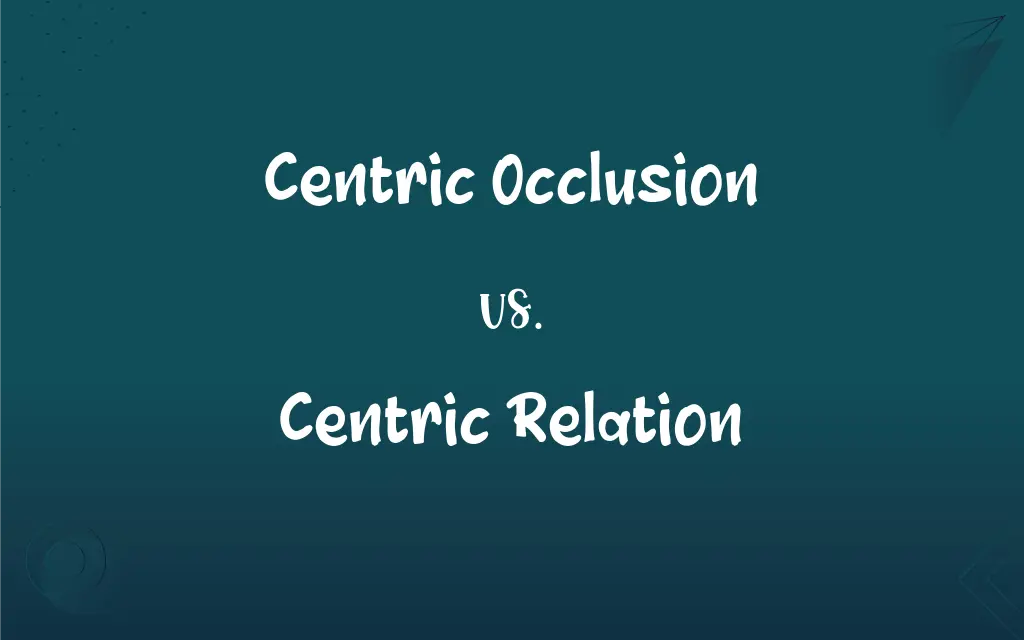Centric Occlusion vs. Centric Relation: What's the Difference?
Edited by Aimie Carlson || By Janet White || Published on December 29, 2023
Centric Occlusion is the position where upper and lower teeth fit together perfectly, while Centric Relation is the jaw's position when the condyles are in their most upward, backward, and centralized position.

Key Differences
Centric Occlusion refers to the ideal occlusion of the teeth, where the upper and lower teeth are in their best fit, usually during biting or chewing. This is a static relationship based on the contact between teeth. Centric Relation, on the other hand, is a concept related to the alignment of the jaw joints (temporomandibular joints) in their most unstrained position, independent of tooth contact.
In Centric Occlusion, the focus is on the optimal positioning of the teeth for effective mastication and aesthetics. It's a tooth-driven concept and is essential for the proper function of the dental arches. In contrast, Centric Relation is more about the functional position of the jaw and is considered a jaw-driven concept. It's used as a reference point in restorative dentistry and orthodontics.
The Centric Occlusion is often used in general dental practice to assess and treat common dental issues, focusing on how well the teeth occlude. Centric Relation is used in more complex cases, such as when reconstructing occlusions or treating temporomandibular joint disorders, where the position of the jaw is a crucial factor.
Achieving a proper Centric Occlusion is vital for everyday dental health, ensuring that biting and chewing do not cause undue wear or trauma. Centric Relation becomes particularly important in prosthetic dentistry and orthodontics, where the alignment of the jaw can impact the overall treatment plan.
Centric Occlusion is about the best fit of the teeth, while Centric Relation deals with the ideal positioning of the jaw joints. Both concepts are crucial in dentistry but are used differently depending on the context and the dental issues at hand.
ADVERTISEMENT
Comparison Chart
Definition
Optimal fit of upper and lower teeth
Jaw's position with condyles in optimal position
Focus
Teeth alignment and occlusion
Jaw joint alignment
Dental Relevance
Essential for mastication and dental health
Important in prosthetics and orthodontics
Application
Used in general dental practice
Used in complex dental cases
Purpose
Ensures effective biting and chewing
Reference point for jaw alignment
ADVERTISEMENT
Centric Occlusion and Centric Relation Definitions
Centric Occlusion
The optimal intercuspation of the upper and lower teeth.
Her centric occlusion was corrected with orthodontic treatment.
Centric Relation
Jaw position independent of tooth contact.
Centric relation is often a starting point in reconstructive dentistry.
Centric Occlusion
The optimal fit of the upper and lower teeth.
The dentist adjusted the filling to improve centric occlusion.
Centric Relation
The most retruded physiologic position of the mandible.
The orthodontist assessed her centric relation for the treatment plan.
Centric Occlusion
Ideal positioning of teeth for effective mastication.
He had braces to achieve better centric occlusion.
Centric Relation
The jaw's position with condyles in their optimal alignment.
Centric relation is key in designing dental prosthetics.
Centric Occlusion
The position of teeth that provides the most contact and stability.
Centric occlusion is checked during regular dental exams.
Centric Relation
The ideal position of the jaw for prosthetic reconstruction.
Accurate recording of centric relation is crucial for implant placement.
Centric Occlusion
The relationship between dental arches when teeth are in maximum contact.
Proper centric occlusion is essential for effective chewing.
Centric Relation
The maxillo-mandibular relationship with the condyles in the anterior-superior position.
Adjustments were made to his dentures based on his centric relation.
FAQs
Why is Centric Occlusion important in dentistry?
It's important for diagnosing and planning dental treatments, ensuring proper bite and jaw alignment.
How is Centric Occlusion determined?
It is determined by the patient's natural bite when they close their mouth normally.
Can Centric Occlusion change over time?
Yes, it can change due to factors like tooth loss, wear, or dental treatments.
What is Centric Occlusion (CO)?
Centric Occlusion is the position where the upper and lower teeth are in maximum contact and intercuspation.
Is Centric Occlusion the same for everyone?
No, it varies from person to person based on their dental anatomy.
What is Centric Relation (CR)?
Centric Relation is the jaw position where the condyles are in their most uppermost, anterior, and midmost position in the glenoid fossa.
How is Centric Relation determined?
It is determined manually by guiding the lower jaw to its most retruded physiologic position.
Is Centric Occlusion the same as the ideal bite?
It is often considered the ideal bite, but not always optimal in terms of function or health.
How do dentists correct Centric Occlusion issues?
Treatment can involve orthodontics, restorations, or occlusal adjustments.
Can Centric Occlusion be used to design dental prosthetics?
Yes, it's crucial for designing functional and comfortable dental prostheses.
How does Centric Relation differ from Centric Occlusion?
CR is a jaw position, while CO is a tooth position; they may not always coincide.
Can Centric Relation be uncomfortable?
If not aligned properly, it can lead to discomfort or temporomandibular joint issues.
What problems can occur with Centric Occlusion?
Issues can include tooth wear, temporomandibular joint disorders, and muscle discomfort.
Does Centric Relation change with age?
Unlike CO, CR is generally stable throughout life and doesn't change significantly with age.
Is Centric Relation important for all dental treatments?
It is especially important for reconstructive and prosthetic dental treatments.
How do dentists record Centric Relation?
Dentists use techniques like bimanual manipulation or leaf gauge to record CR.
What role does Centric Relation play in orthodontics?
It helps in planning orthodontic treatment to achieve a harmonious bite.
How does tooth loss affect Centric Occlusion?
Tooth loss can lead to bite changes and misalignment in Centric Occlusion.
Can CR be altered with dental treatment?
Direct alteration of CR is not typical, but dental treatments can influence the relationship between CR and CO.
Why is Centric Relation significant in dentistry?
It's a repeatable reference position used in diagnosis and treatment planning, particularly in prosthodontics.
About Author
Written by
Janet WhiteJanet White has been an esteemed writer and blogger for Difference Wiki. Holding a Master's degree in Science and Medical Journalism from the prestigious Boston University, she has consistently demonstrated her expertise and passion for her field. When she's not immersed in her work, Janet relishes her time exercising, delving into a good book, and cherishing moments with friends and family.
Edited by
Aimie CarlsonAimie Carlson, holding a master's degree in English literature, is a fervent English language enthusiast. She lends her writing talents to Difference Wiki, a prominent website that specializes in comparisons, offering readers insightful analyses that both captivate and inform.






































































